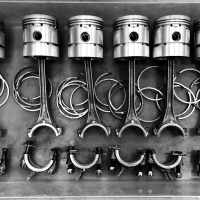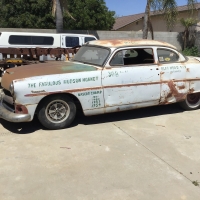Bench Racing!
So today I’ve been doing some bench racing while working on the old 37 Hudson. Along those lines I’m wondering just how much carburetion my little 212ci engine can’t handle. I found it interesting that the terraplane had a one barrel carb while my six has a two barrel carb & to me that spears to be a doubling of carburetion with no other changes to the engine. So my “bench racing” question is how much more carburetion can this 212ci engine handle?
To help this discussion here are the basics of my 212ci engine is standard bore. With the engine refresh last year I honed cylinders with new rings on stock pistons, new 1938 & later valves (for their smaller stem diameter) with matching cutback valve guides and a complete porting of the engine with gasket matching to help airflow. However intake & exhaust valve head size are both still 1.375“ & the compression is around 8.5:1. Everything else is stock.
Sitting on my shelf is a straight 8 carb WGD & measuring the bottom of each barrel I find 1.3” vs my stock carb at 1”. Now it’s not a direct bolt up since the bolt pattern is larger but perhaps someone has already done this & has made an adapter?
0
Comments
-
Found this formula for determining CFM based upon engine size, which gives me around 200cfm. Anyone know what Hudson carbs had for cfm?0
-
The Weber 32/36 progressive two barrel may be a good choice for you. It's 240 CFM.0
-
I’d just plug a vacuum gauge into the wiper port of the inlet manifold then do a few full thottle pulls to maximum rpm. If it’s pulling more than an inch or so of vacuum that indicates under-carburetion. You may find in fact that your standard carb is fine. I know my single barrel Terraplane pulls several pounds of vacuum doing this.The issue with carbureting for max. power is driveability - with a big non-progressive twin-choke carb you will likely lose low-speed flexibility, ie bog down. The Langdon’s Chev Stovebolt site sells the Weber progressive 32/36 as the best carb for the pre-war Chev sixes.0
-
Also, I found a heap of really interesting stuff here: https://fordsix.com/ci/LogMods.html
The links at the bottom of the page are good too, plus this: https://fordsix.com/ci/CarbChoice.html
0 -
It hit 60 degrees here so out came my 37 coupe. She has 500 miles on the engine refresh, great compression & is running strong. So after driving her a bit over 40 miles & knowing friends are at the El Mirage dry lake beds doing land speed racing I got the speed itch.Some quick math and my goal was to hit 90mph, which would be around 3,750 rpm. However, I have still been getting a lot of clutch slippage so I wasn’t sure if it was even possible. Below is the video I took of my top speed run down Montana interstate & you can hear the clutch slipping a bunch (74mph, 80mph, etc.) as I get up to speed.No seatbelts, no airbags, 83 year old technology, driving with one hand & video taping with the other..... what could go wrong?
https://youtu.be/m8fWD3TsAaw0
Categories
- 36.9K All Categories
- 112 Hudson 1916 - 1929
- 20 Upcoming Events
- 92 Essex Super 6
- 28.6K HUDSON
- 571 "How To" - Skills, mechanical and other wise
- 995 Street Rods
- 151 American Motors
- 178 The Flathead Forum
- 49 Manuals, etc,.
- 78 Hudson 8
- 44 FORUM - Instructions and Tips on using the forum
- 2.8K CLASSIFIEDS
- 608 Vehicles
- 2.1K Parts & Pieces
- 77 Literature & Memorabilia
- Hudson 1916 - 1929 Yahoo Groups Archived Photos

